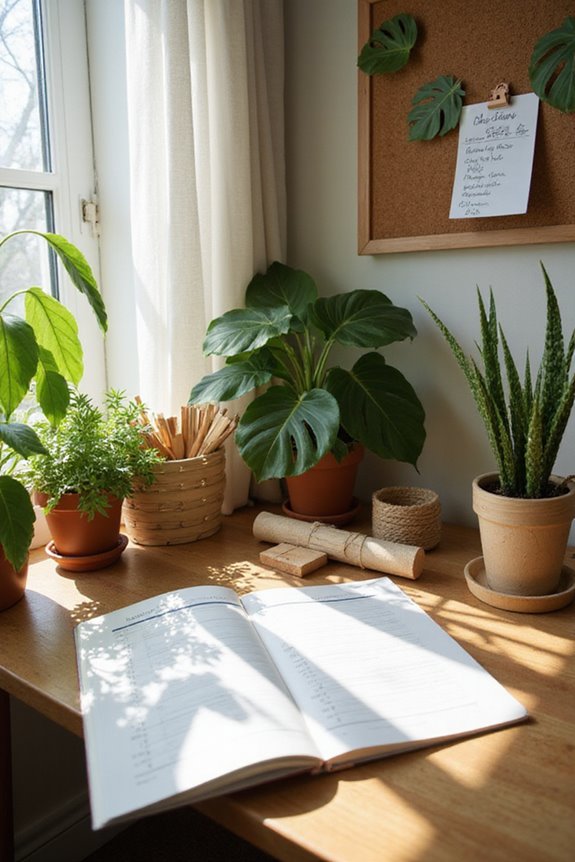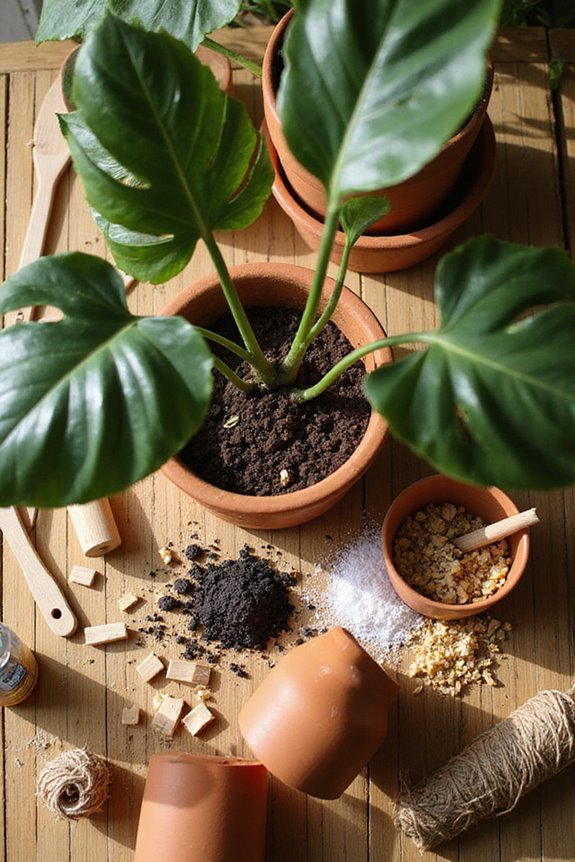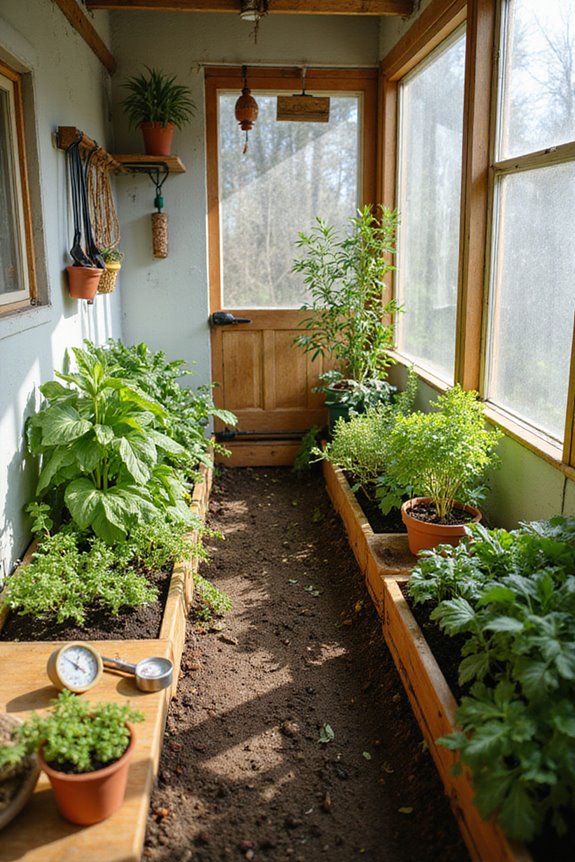Creating plant care schedules starts with understanding our plants’ needs. First, we assess light intensity, watering frequency, and nutrient balance. Next, we can create a care calendar, marking days for watering, fertilizing, and pruning. It’s also important to categorize plants by their specific requirements, like high, medium, or low light needs. Finally, monitoring environmental changes helps us adjust schedules. By following these steps, we can guarantee our plants thrive, and there’s more to explore on optimizing care!
Key Takeaways
- Identify each plant’s specific light, watering, and nutrient needs to customize care schedules accordingly.
- Utilize a digital app or printable calendar to schedule regular watering, fertilization, and pruning tasks.
- Set reminders for light adjustments as seasons change to meet plant light requirements.
- Conduct regular soil testing and monitor environmental changes to adapt care routines effectively.
- Tailor your care calendar to the unique growth patterns and characteristics of each plant type.
Identify Plant Needs
Identifying plant needs is essential for successful plant care. Each plant species has unique requirements that we must consider. We need to assess light intensity, as some plants thrive in bright light while others prefer low light.
Watering frequency is also important; we should check soil moisture to avoid overwatering or underwatering. Additionally, maintaining nutrient balance is crucial for healthy growth. Regular soil testing can help us identify nutrient deficiencies. Implementing practices like composting and mulching can further enhance soil health and contribute to optimal nutrient availability.
Temperature ranges can affect plant health, so we should make sure they stay within ideal levels. Finally, humidity levels play a significant role, especially for tropical plants needing more moisture. By understanding these factors, we can create a thriving environment for our plants.
Create a Care Calendar
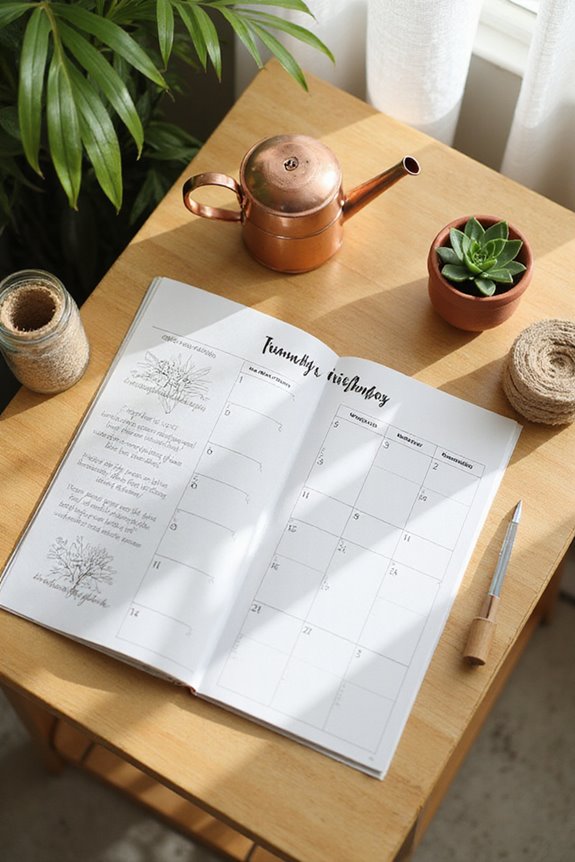
Creating a care calendar is a crucial step in ensuring our plants thrive. We can choose between various calendar formats, like digital apps such as Notion or Google Calendar, and printable paper calendars. Each method has its benefits; digital options allow for reminders and easy edits, while printables give us a visual reference without needing technology.
To set up our calendar, we can consider scheduling methods that include:
- Watering and Fertilization: Assign specific days for watering based on plant needs.
- Light Adjustment: Mark periods for changing light exposure.
- Pruning and Pest Management: Allocate times for pruning and pest checks.
Understand Different Plant Types
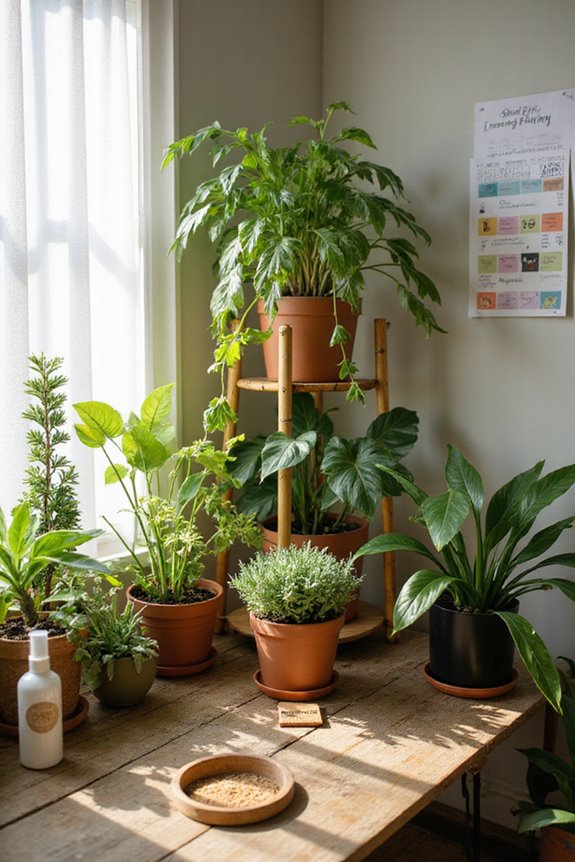
Understanding different plant types is essential for successful plant care. By recognizing their unique plant characteristics, we can better meet their needs.
- Light Requirements:
- High-light plants, like succulents and cacti, need direct sunlight.
- Medium-light plants, such as philodendrons, thrive in bright, indirect light.
- Low-light plants, including ZZ plants, tolerate shaded areas.
- Drought-tolerant plants, like the ponytail palm, require less water.
- Moderate-water plants prefer consistent moisture, while overwatering-sensitive plants need minimal watering.
- Compact plants suit small spaces, while vining types need support.
- Understanding these growth patterns helps us create effective care schedules tailored to each plant’s requirements. Additionally, container options that provide adequate space and drainage can further enhance plant health and growth.
Assess Soil Conditions
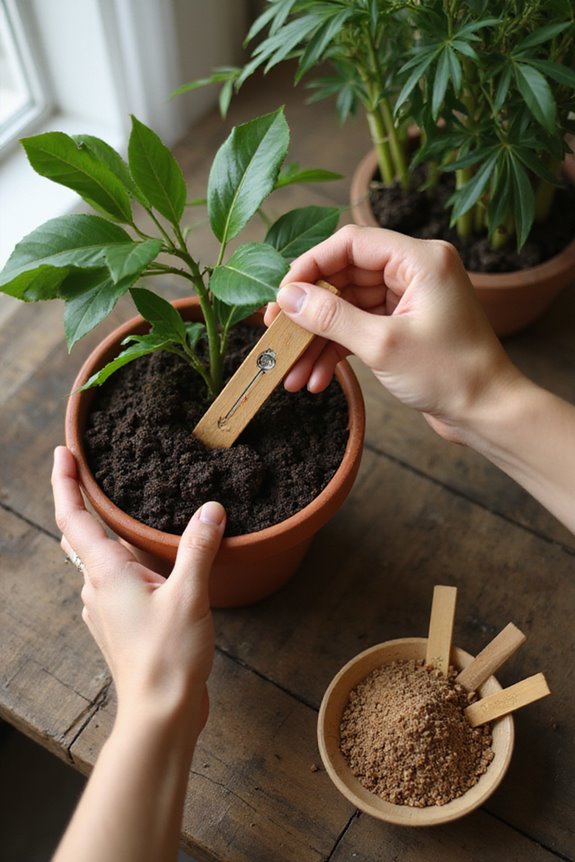
Evaluating soil conditions is an essential step in creating effective plant care schedules. To get started, we should conduct soil sampling across our fields. This means dividing our fields into different sampling units based on soil type and crop growth. By doing this, we’ll gain a clearer understanding of soil properties that affect our plants.
Key soil properties to assess include:
- Soil Texture: Determine the proportions of sand, silt, and clay.
- Soil Structure: Look for indicators like friability and clod size.
- Soil pH: Understand how it influences nutrient availability.
These assessments help us track changes over time and make better decisions for our plant care schedules. Let’s guarantee we’re monitoring our soil effectively!
Monitor Environmental Changes
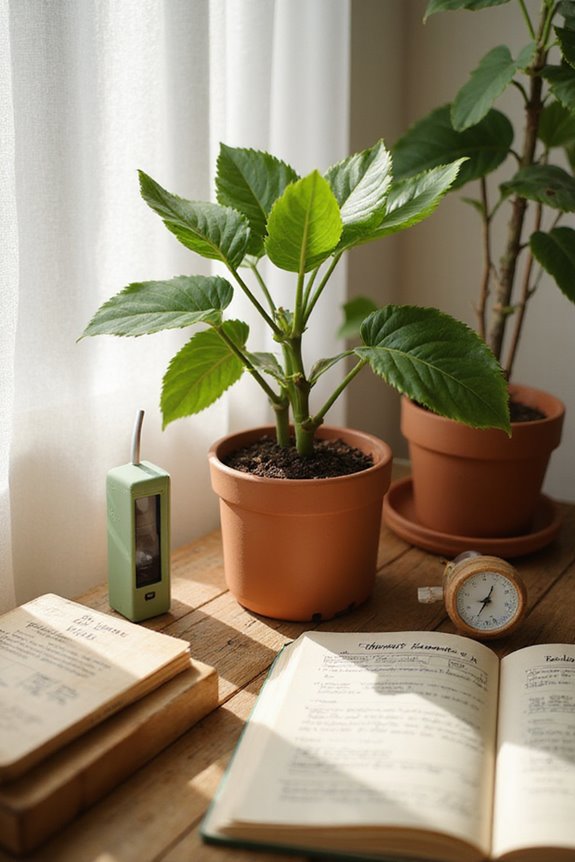
Monitoring environmental changes is vital for maintaining plant health and guaranteeing effective care schedules. By keeping an eye on pollution indicators, we can better understand how toxins in the air, soil, and water affect our plants. For instance, transgenic plants can serve as bioindicators, detecting harmful chemicals like PCBs in real-time.
Atmospheric monitoring plays a significant role, too. Organizations like CASTNET track air pollutants and their impact on plant health. This data informs us about necessary adjustments to watering and fertilization schedules. By combining information from air quality and soil assessments, we can adapt our care routines to make sure our plants thrive despite environmental challenges. Let’s stay informed and proactive to give our plants the best care possible.
Customize Schedules for Each Plant
Customizing care schedules for each plant is essential to guarantee ideal growth and health. Each plant has unique needs, like watering frequency and nutrient requirements. For example, fast-growing herbs may need more frequent watering than slow-growing shrubs.
- Create Plant Profiles: Start by noting the specific needs of each plant, including their growth stages and light exposure.
- Adjust Watering: Schedule watering based on these profiles. Seedlings require gentler, frequent watering, while mature plants can handle deeper but less frequent watering.
- Consider Seasonal Changes: Be prepared to adjust schedules with the seasons. Warmer months typically demand more water, especially for herb container gardens that may require more attention during active growth periods.
Utilize Technology and Resources
Incorporating technology into our plant care routines can greatly enhance how we manage our gardens. Smart apps like Planta utilize algorithms based on local climate data to send us personalized reminders for watering and fertilizing. They can even diagnose plant health issues with photos, offering tailored treatments.
Using garden management software like Seedtime, we can create customized planting schedules. These platforms allow us to adjust schedules easily while providing warnings if changes could harm our plants.
Additionally, community support within these apps lets us exchange care tips and share experiences. Engaging with fellow plant lovers fosters a sense of belonging, making plant care a more enjoyable journey. Together, we can thrive in our gardening adventures.
Schedule Seasonal Adjustments
When we think about plant care, scheduling seasonal adjustments is vital for keeping our plants healthy and thriving. Each season brings unique needs for our plants that we must consider. For instance, during spring and summer, plants experience active growth, requiring more water and nutrients. Conversely, in winter, we should reduce watering to prevent root rot.
- Adjust watering: Water deeply in summer but lessen frequency in winter.
- Light management: Guarantee adequate light exposure; consider using grow lights indoors.
- Soil care: Prepare soil in spring and add organic matter in autumn. Additionally, using hydroponics systems can help optimize growth by providing a controlled environment year-round.
Frequently Asked Questions
How Do I Know if My Plant Is Overwatered?
When it comes to knowing if our plant’s overwatered, let’s keep an eye out for plant droopiness and soil saturation. If leaves are wilting and soil’s soggy, we might need to rethink our watering routine!
What Tools Are Best for Measuring Soil Moisture?
When we’re measuring soil moisture, soil moisture meters are invaluable. They help us understand moisture retention, ensuring our plants thrive. Let’s explore the best tools together, enhancing our gardening experience and nurturing our green spaces!
Can I Use Regular Tap Water for Houseplants?
Like a hidden treasure chest, tap water quality holds secrets for our houseplants. While some thrive, others may struggle. We should always consider our plants’ water preferences before pouring that familiar liquid into their pots.
How Often Should I Fertilize My Plants?
When fertilizing our plants, we should consider their specific nutrient requirements and fertilizer types. Generally, heavier feeders need more frequent feedings, while lighter ones thrive with less. Together, we can guarantee our plants flourish beautifully!
What Are Signs of Pests in My Plants?
We’ve all felt the struggle of unwelcome visitors. For pest identification, we should look for sticky leaves, webbing, or distorted foliage. Effective pest control starts with recognizing these signs before they wreak havoc on our plants.

